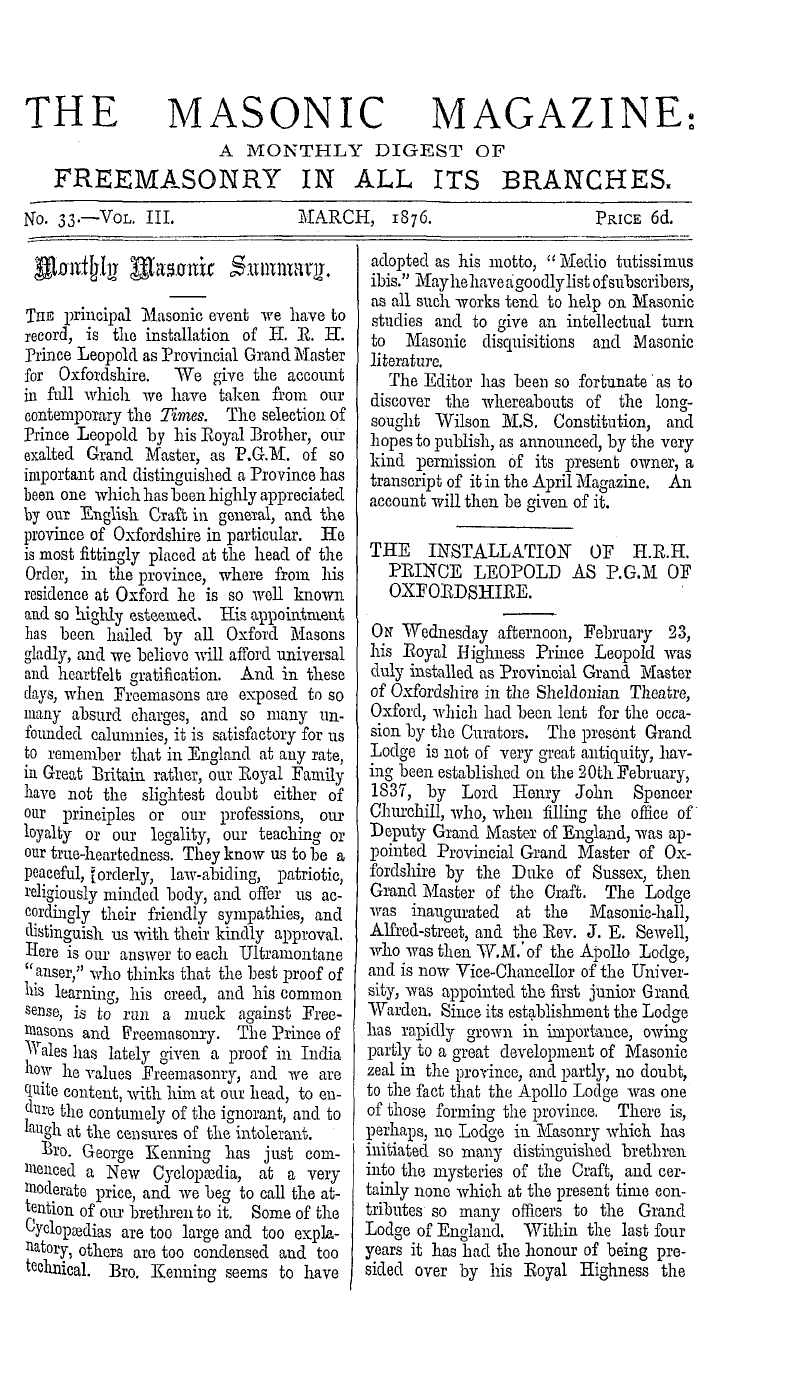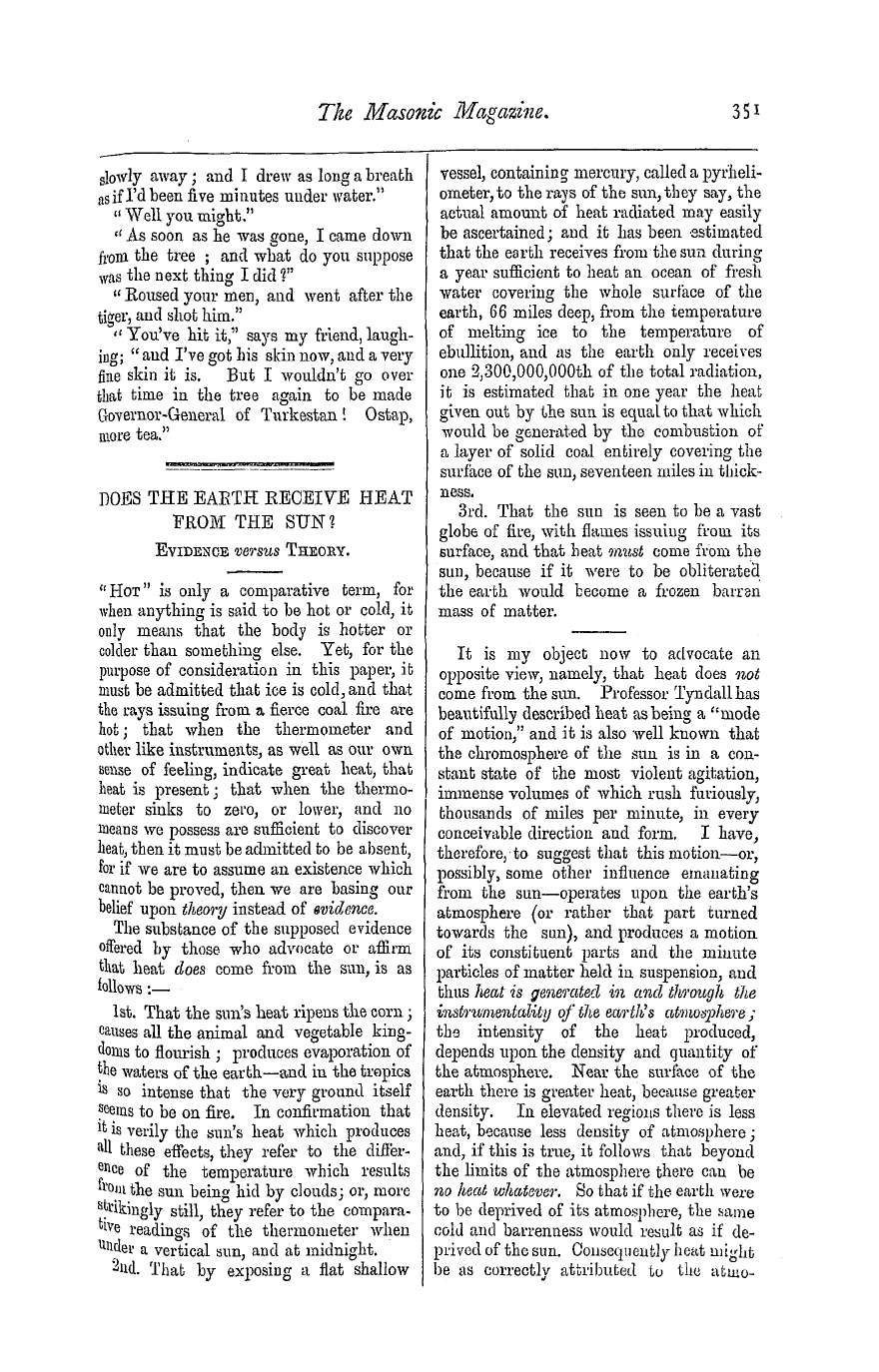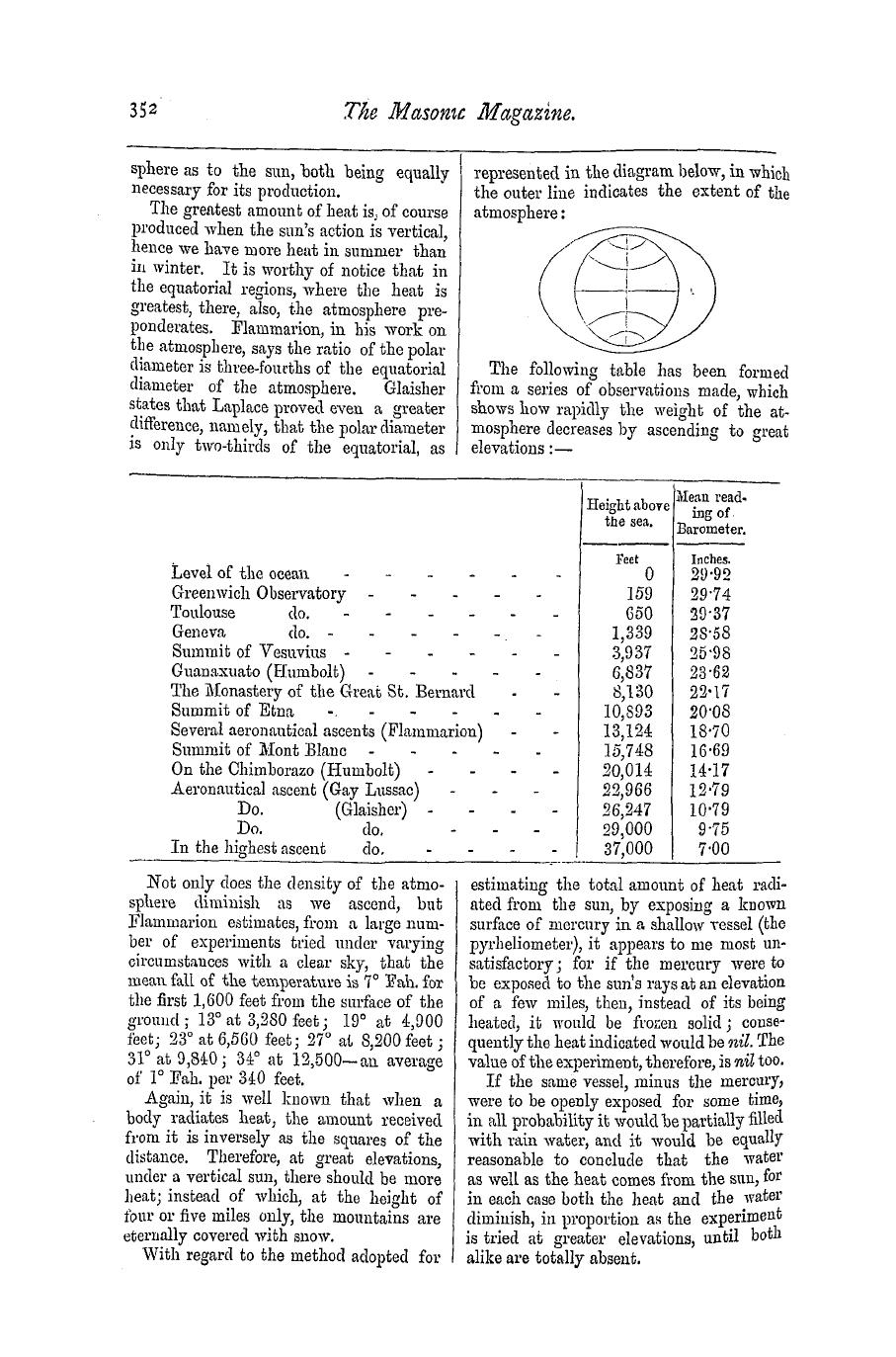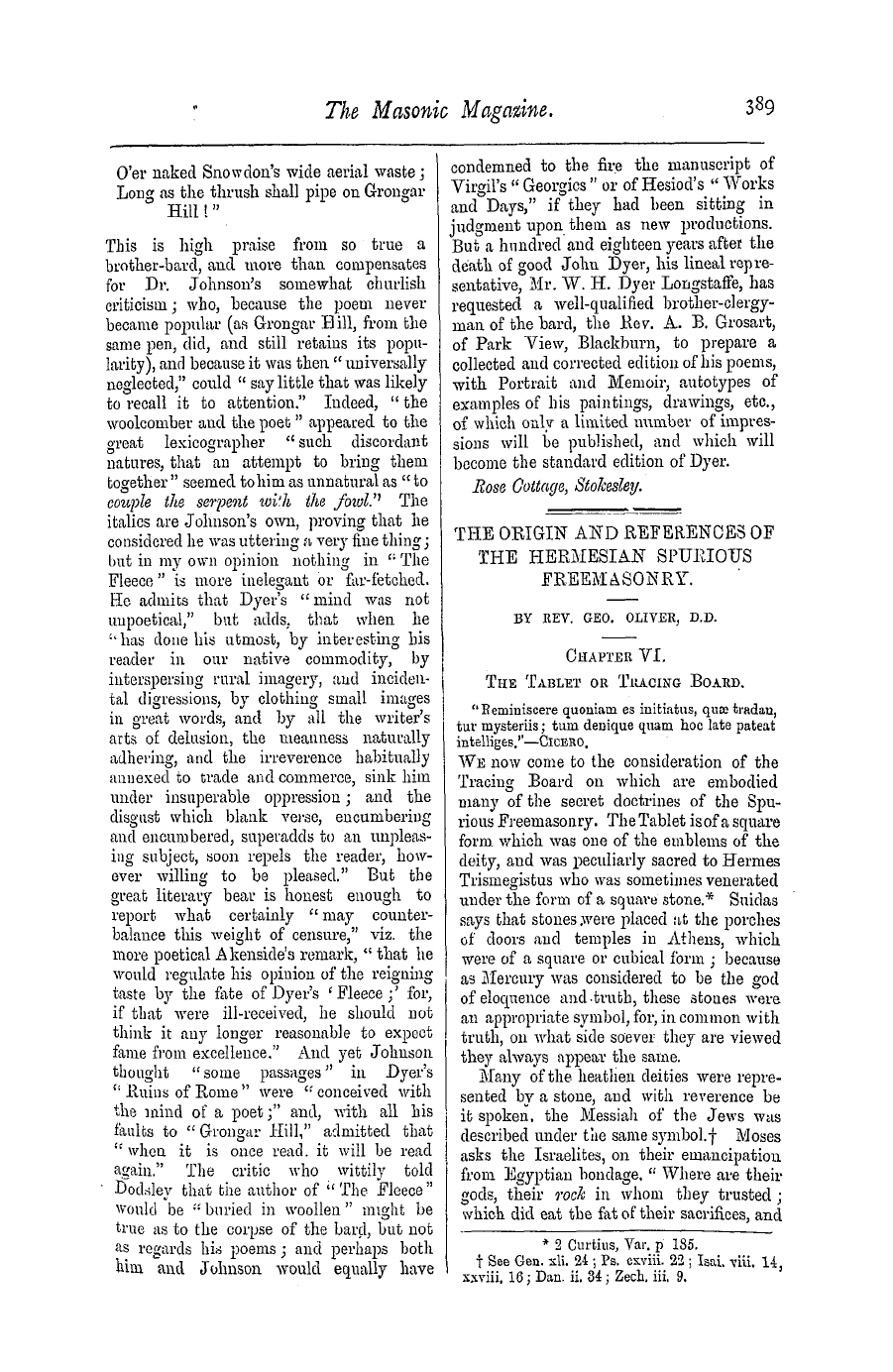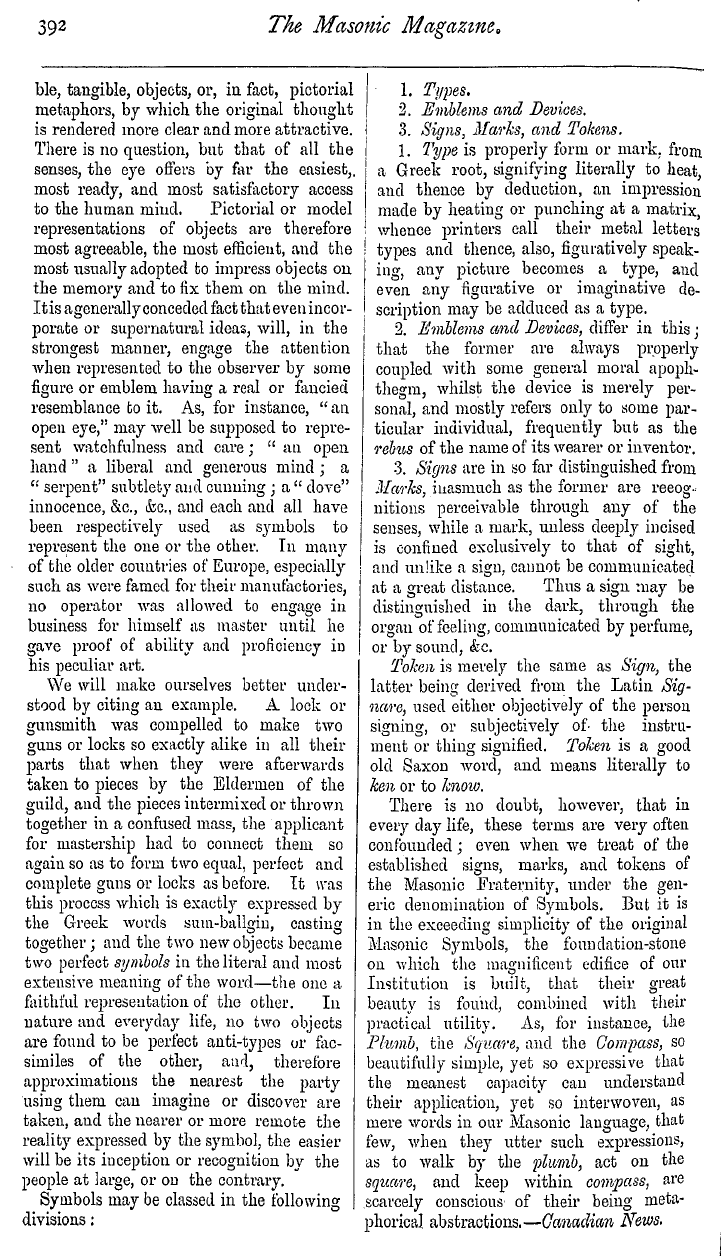-
Articles/Ads
Article THE MEANING AND DERIVATION OF SYMBOL. ← Page 2 of 2
Note: This text has been automatically extracted via Optical Character Recognition (OCR) software.
The Meaning And Derivation Of Symbol.
ble , tangible , objects , or , in fact , pictorial metaphors , by which the original thought is rendered more clear and more attractive . There is no question , but that of all the senses , the eye offers by far the easiest ,, most ready , ancl most satisfactory access
to the human mind . Pictorial or model representations of objects are therefore most agreeable , the most efficient , and the most usually adopted to impress objects on the memory and to fix them on the mind . Itis agenerally conceded fact that
evenincorporate or supernatural ideas , will , in the strongest manner , engage the attention when represented to the observer by some figure or emblem having a real or fancied resemblance to it . As , for instance , " an open eye" may well be supposed to
repre-, sent watchfulness ancl care ; " an open hand " a liberal ancl generous mind ; a " serpent" subtlety and cunning ; a " clove " innocence , & c , ( fee ., and each and all have been respectively used as symbols to represent the one or the other . Iu many
of the older countries of Europe , especially such as were famed for their manufactories , no operator was allowed to engage in business for himself as master until he
gave proof of ability ancl proficiency in his peculiar art . We will make ourselves better understood by citing an example . A lock 01 gunsmith was compelled to make two guns or locks so exactly alike iu all their jiarts that when they were afterwards
taken to pieces by the Eldermen of the guild , and the pieces intermixed or thrown together in a confused mass , the applicant for mastership had to connect them so again so as to form two equal , perfect ancl complete guns or locks as before . It was
this process which is exactly expressed by the Greek words sum-ballgin , casting together ; and the two new objects became two perfect symbols in the literal and most extensive meaning of the word—the one a faithful representation of the other . In
nature and everyday life , no two objects are found to be perfect anti-types or facsimiles of the other , and , therefore approximations the nearest the party using them can imagine or discover are taken , ancl the nearer or more remote the
reality expressed by the symbol , the easier will be its inception or recognition by the people at large , or on the contrary . Symbols may be classed in the following divisions :
1 . Types . 2 . Emblems and Devices . 3 . Signs , Marks , and Tokens . 1 . Type is properly form or mark , from a Greek root , signifying literally to heat , and thence by deduction , an impression
made by heating or punching at a matrix , whence printers call their metal letters types ancl thence , also , figuratively speaking , any picture becomes a type , and even any figurative or imaginative descrition may be adduced as a type .
p 2 . Emblems and Devices , differ in this ; that the former are always properl y coupled with some general moral apophthegm , whilst the device is merely personal , and mostly refers only to some
particular individual , frequently but as the rebus of the name of its wearer or inventor . 3 . Signs are in so far distinguished from Marks , inasmuch as the former are reeognitions perceivable through any of the senses , while a mark , unless deeply incised
is confined exclusively to that of sight , and unlike a sign , cannot be communicated at a great distance . Thus a sign may be distinguished in the dark , through the organ of feeling , communicated by perfume , or by sound , < fee .
Token is merely the same as Sign , the latter being derived from the Latin Signare , used either objectively of the person signing , or subjectively of the instrument or thing signified . Token is a good old Saxon word , ancl means literally to ken or to know .
There is no doubt , however , that in every day life , these terms are very often confounded ; even when we treat of the established signs , marks , and tokens of the Masonic Fraternity , under the generic denomination of Symbols . But it is in the exceeding simplicity of the orig inal
Masonic Symbols , the foundation-stone on which the magnificent edifice of our Institution is built , that their great beauty is found , combined with their practical utility . As , for instance , the Plumb , the Square , and the Compass , so
beautifully simple , yet so expressive that the meanest capacity can understand their application , yet so interwoven , as mere words in our Masonic language , that few , when they utter such expressions , as to walk by the plumb , act on the square , and keep within compass , are scarcely conscious of their being metaphorical abstractions . — Canadian News .
Note: This text has been automatically extracted via Optical Character Recognition (OCR) software.
The Meaning And Derivation Of Symbol.
ble , tangible , objects , or , in fact , pictorial metaphors , by which the original thought is rendered more clear and more attractive . There is no question , but that of all the senses , the eye offers by far the easiest ,, most ready , ancl most satisfactory access
to the human mind . Pictorial or model representations of objects are therefore most agreeable , the most efficient , and the most usually adopted to impress objects on the memory and to fix them on the mind . Itis agenerally conceded fact that
evenincorporate or supernatural ideas , will , in the strongest manner , engage the attention when represented to the observer by some figure or emblem having a real or fancied resemblance to it . As , for instance , " an open eye" may well be supposed to
repre-, sent watchfulness ancl care ; " an open hand " a liberal ancl generous mind ; a " serpent" subtlety and cunning ; a " clove " innocence , & c , ( fee ., and each and all have been respectively used as symbols to represent the one or the other . Iu many
of the older countries of Europe , especially such as were famed for their manufactories , no operator was allowed to engage in business for himself as master until he
gave proof of ability ancl proficiency in his peculiar art . We will make ourselves better understood by citing an example . A lock 01 gunsmith was compelled to make two guns or locks so exactly alike iu all their jiarts that when they were afterwards
taken to pieces by the Eldermen of the guild , and the pieces intermixed or thrown together in a confused mass , the applicant for mastership had to connect them so again so as to form two equal , perfect ancl complete guns or locks as before . It was
this process which is exactly expressed by the Greek words sum-ballgin , casting together ; and the two new objects became two perfect symbols in the literal and most extensive meaning of the word—the one a faithful representation of the other . In
nature and everyday life , no two objects are found to be perfect anti-types or facsimiles of the other , and , therefore approximations the nearest the party using them can imagine or discover are taken , ancl the nearer or more remote the
reality expressed by the symbol , the easier will be its inception or recognition by the people at large , or on the contrary . Symbols may be classed in the following divisions :
1 . Types . 2 . Emblems and Devices . 3 . Signs , Marks , and Tokens . 1 . Type is properly form or mark , from a Greek root , signifying literally to heat , and thence by deduction , an impression
made by heating or punching at a matrix , whence printers call their metal letters types ancl thence , also , figuratively speaking , any picture becomes a type , and even any figurative or imaginative descrition may be adduced as a type .
p 2 . Emblems and Devices , differ in this ; that the former are always properl y coupled with some general moral apophthegm , whilst the device is merely personal , and mostly refers only to some
particular individual , frequently but as the rebus of the name of its wearer or inventor . 3 . Signs are in so far distinguished from Marks , inasmuch as the former are reeognitions perceivable through any of the senses , while a mark , unless deeply incised
is confined exclusively to that of sight , and unlike a sign , cannot be communicated at a great distance . Thus a sign may be distinguished in the dark , through the organ of feeling , communicated by perfume , or by sound , < fee .
Token is merely the same as Sign , the latter being derived from the Latin Signare , used either objectively of the person signing , or subjectively of the instrument or thing signified . Token is a good old Saxon word , ancl means literally to ken or to know .
There is no doubt , however , that in every day life , these terms are very often confounded ; even when we treat of the established signs , marks , and tokens of the Masonic Fraternity , under the generic denomination of Symbols . But it is in the exceeding simplicity of the orig inal
Masonic Symbols , the foundation-stone on which the magnificent edifice of our Institution is built , that their great beauty is found , combined with their practical utility . As , for instance , the Plumb , the Square , and the Compass , so
beautifully simple , yet so expressive that the meanest capacity can understand their application , yet so interwoven , as mere words in our Masonic language , that few , when they utter such expressions , as to walk by the plumb , act on the square , and keep within compass , are scarcely conscious of their being metaphorical abstractions . — Canadian News .
